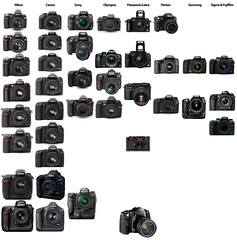 Image by penmachine via Flickr
Image by penmachine via Flickr
If you haven't already read the first post, go and do it now. Trust me, this second post will make a lot more sense if you do. Part 2 of this guide will cover the light meter, depth of field, and how to set proper exposure.
The Light Meter
The light meter is a built-in device that takes a measurement of the amount of light available in the particular scene that you're trying to photograph. Once the light meter takes a 'reading' of the light, it will give you recommendations as to whether or not your current settings will give you a correct exposure.To take a meter reading, press the shutter release button (the button that takes the pictures) halfway down. This will activate the light meter and take a reading.
On the top LCD panel you'll see a bar with a zero in the center, a +1 and +2 on the right, and a -1 and -2 on the left. A bar will be blinking somewhere over these numbers. This is in essence, the light meter. In the image below it is labeled the Exposure Level:

If the bar is blinking over the +2 this means your setting are incorrect and are OVER-EXPOSING by 2 stops (aperture or shutter speed). If the bar is blinking over the -2 the settings are incorrect and are UNDER-EXPOSING by two stops.
The key to understanding this is to understand that "stops" can be either apertures OR shutter speeds.
To correct the exposure, change the aperture or shutter speed so the bar blinks over the "0" in the center of the bar. If the bar is in the center, you have successfully corrected the setting and you now have a correct exposure.
Depth Of Field
So in essence, all you need to do to get a correct exposure is change the aperture or shutter speed until the blinking bar hovers over the "0" in the exposure level diagram. Easy right? Well, not so fast! The problem with this strategy is that it doesn't take into account a phenomenon known as depth of field. I covered this in an earlier post, but it's worth repeating.Depth of Field refers to the amount of the image, from near to far, that is acceptably in focus.
Photographing food with blurry atmospheric backgrounds is really popular now, and this is how you do it.
The smaller the aperture NUMBER, the MORE blurry the background will be. The larger the aperture NUMBER, the LESS blurry and more sharp the background will be.
At this point it becomes a matter of personal preference. I personally like blurry backgrounds, but if you like everything in your photo to be sharp, then you'll need to shoot with a large aperture number.
At this point you might be asking, "but if I change the aperture to a large number, the bar above the "0" changes. What do I do then?"
When changing the aperture in one direction, the shutter speed needs to be changed in the opposite direction to compensate, and vice versa.
Still with me? Good. Just a bit more to go.
A Word About Shutter Speed
When compensating the exposure by changing the shutter speed be careful not to go under the number 30. Anything below a 30 risks being blurry because of the camera moving. You CAN shoot below a 30 but only if you are shooting with a tripod, which I highly recommend anyway.And that's it! Consider yourself a professional! Any questions or clarifications? Just leave a question in the comments and I'll get right to it.
And here is Part 1 if you missed it.
![Reblog this post [with Zemanta]](http://img.zemanta.com/reblog_e.png?x-id=96769d56-2ec3-46cf-af2e-711acd255d3b)
What if you're indoors, and your ISO is in 100, can you just lower the shutter speed instead of increasing the ISO number?
ReplyDeleteDivina,
ReplyDeleteYes you can lower the shutter speed instead of raising the ISO but be careful that you don't go lower than a 30th of a second if you're hand-holding the camera, other wise you'll get blurry images because of camera movement. If you're shooting on a tripod, you're ok to go lower.
The rule of thumb is 1/(the lens focal length). So if you have a 50mm, your shutter speed should not be slower than 1/50 sec. Generally, most would recommend not going slower than 1/60 sec while hand held.
ReplyDelete